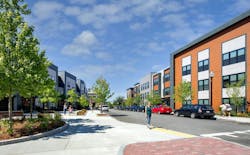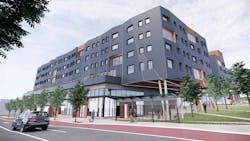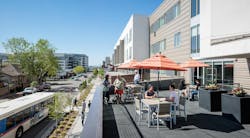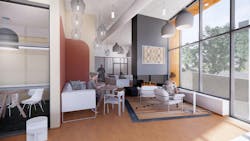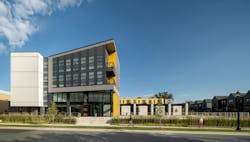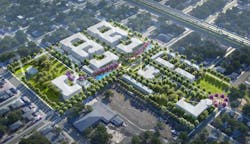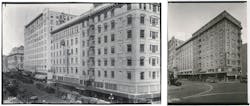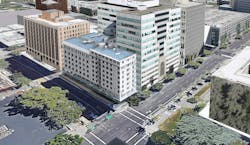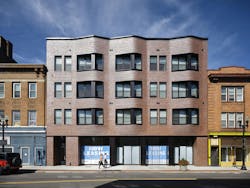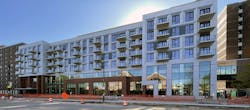Top 10 trends in affordable housing
By Quinn Purcell, Managing Editor
This article first appeared in BD+C's 2023 Multifamily Annual Report—our first-ever “state of the state” special report on the multifamily housing construction sector. To download the full 76-page report, click here.
As of May 2023, the average rent in the U.S. reached $1,995—double the amount it was 10 years ago. With the cost of living rising every year, there’s never been a greater need for affordable housing development. This is, however, easier said than done. Affordable housing has historically had challenges ranging from financing to public perception. Still recovering from Coronavirus-era housing industry difficulties and a decline in federal funding incentives, project leaders are finding ways to do more with less.
“The nation as a whole is in desperate need of affordable housing in every jurisdiction,” says Douglas Carter, AIA, Principal-in-Charge and President, DCS Design. “The demand is insatiable and the challenge for 2024 will be both financing and inflation.”
Among affordable housing developers today, there’s one commonality tying projects together: uncertainty. Architecture, engineering, and construction firms share their latest insights and philosophies on the future of affordable housing. Here are the top 10 trends in the affordable housing sector:
1. Passive House-influenced design
Influenced by an industry-wide increase in sustainability concerns, Passive House principles have made its way into affordable housing. The tenets of Passive House design include airtight insulation, energy recovery ventilation, high-performance windows and doors, and thermal bridge free construction.
Studies have shown that Passive House residents are more comfortable living in the space when compared to traditional buildings. This can be attributed to the consistent air temperatures, humidity levels, and acoustic comfort that Passive House design provides.
In today’s affordable housing landscape, request for proposals (RFPs) are identifying a desire for net zero operational, Passive House, and WELL building standards—more than just green design. Affordable housing projects are now incorporating more passive solar designs, highly efficient HVAC systems, and heavily insulated walls to achieve these standards.
The GBBN Architects-designed development, Fifth & Dinwiddie West in Pittsburgh, Pa., is slated to be a 190,000-sf mixed-income community with Passive House principles. Due to its passive design, the building team anticipates Fifth & Dinwiddie will yield a 70% reduction in energy use.
The overall goal of utilizing Passive House design is to create a holistic system that helps reduce operational costs, create a healthier environment for residents, and meet new government mandates—especially when combined with existing programs like the Low-Income Housing Tax Credit (LIHTC).
For example, The Architectural Team, a Boston-based architecture firm, has benefited from local incentives like Boston’s Building Emissions Reduction and Disclosure Ordinance (BERDO) that limits large buildings’ greenhouse gas emissions. The Anne M. Lynch Homes at Old Colony in South Boston contains 116 LEED Platinum-certified affordable units, a 10,000-sf LEED Gold-certified Tierney Learning Center, and 55 Passive House-certified units for seniors and people with disabilities.
2. Increase in market-rate design and amenities
Across the board, we’re seeing an increase in amenities that were once considered market-rate. Rooftop spaces, outdoor recreation, and courtyards are increasingly common (especially since the Coronavirus pandemic brought more people to the outdoors).
Kimberly Hellekson, AIA, NCARB, Managing Principal with FK Architecture, points to modular construction as a solution for cutting costs where needed. Due to its scalable and repeatable nature, modular construction enables the firm to lower construction costs while maintaining market-rate amenities.
Check out our other multifamily housing sector trends reports:
- Top 10 trends in multifamily rental housing
- Top 10 trends in senior living facilities
- Top 10 trends in student housing (this PDF download requires a short registration)
For architecture and interior design firm CetraRuddy, more clients are asking for expressive and sophisticated façade detailing and materiality, flexible unit floor plans, and features such as smart lighting and touchless controls. The same goes for outdoor amenities on rooftops and in thoughtfully designed terraces and central courtyards.
Affordable housing is also seeing more high-end façade finishes that offer a substantial look and feel, and that fit in more contextually with their surrounding communities. John B. Cruz III, President and CEO, Cruz Companies, has found that residents appreciate living in buildings that feel sophisticated and well-designed.
“Many people feel the brightly colored façade panels that have been in vogue are too similar to the cheap, expedient aluminum siding of years past,” says Cruz. The firm instead opts for brick and other upscale materials, such as composite metal panel rainscreens with a sandstone coloring.
3. Incorporating Trauma-Informed Design for interiors
Affordable housing often serves those in underrepresented groups, such as the impoverished, disabled, or traumatized. With thoughtful design, tenants are able to call their place of residence a sanctuary; for some, this can even make a difference in recovering from trauma.
Trish Nixon, AIA, NCARB, LEED AP, President of LRS Architects, believes that Trauma-Informed Design (TiD) continues to be a significant driver for interior design. TiD creates an environment of safety and security for residents, and is “paramount for those recovering from trauma,” according to Nixon.
Research compiled in Designing for Healing, Dignity & Joy breaks down TiD into three core values: comfort, choice, and community.
Some examples of TiD include creating wider hallways but smaller apartments, or opting for flexible shared spaces rather than individual apartment balconies. It’s also been shown that biophilic design—a piece of the Trauma-Informed Design puzzle—aids in improving mental and physical wellbeing. Reduced stress, better sleep, and lower blood pressure are all shown to be positive outcomes of biophilia.
The key takeaway from the research (which was led by Shopworks Architecture, Group14 Engineering, and the University of Denver) is that amenity areas need to feel safe for residents. Locating amenity areas near staff offices can help build connections among residents, and between residents and staff. The research also found that laundry spaces and trash collection areas are shown to be among the most triggering areas for residents who have experienced homelessness.
The Elisabetta, designed by Shopworks Architecture in Denver, Colo., rethinks the laundry room as a spa-like gathering space, where residents gather to “talk, listen, laugh, or just relax as they do laundry,” according to the research report. In the end, Trauma-Informed Design shifts the focus from housing to healing
4. Adding office/private spaces
Whether in-unit or in shared spaces, private work areas are becoming more common as work-from-home (WFH) increases in popularity. In some cases, developers are achieving this through novel partnerships or shared ownership structures, according to GBBN.
Standard Communities, a national affordable housing developer, dedicates amenity space for private work rooms. Alternatively, firms like Baker Barrios Architects are integrating office space inside residential units to support working from home. Baker Barrios has also found that, despite the increase in in-unit office space, unit sizes overall are getting smaller to boost affordability.
One thing is clear: Private work rooms should be thoughtfully designed with ample lighting, soothing views, and flexibility in mind.
5. Flexible, not focused affordable housing amenities
Where market-rate housing tends to incorporate focused amenities, such as gaming rooms, pools, and lounges, affordable properties are opting for flexibility. BKV Group’s Interior Design Director and Partner, Liza Kapisak, CID, LEED AP, sees more club rooms and common areas being designed to serve multiple purposes.
From celebrations to community meetings to after-school programming, community amenity spaces with moveable furniture allow for expanded accommodation. A lot of thought is being given to how residents will take advantage of community-based amenities like libraries, parks, recreation spaces, and transit, according to GBBN.
In that same vein, amenity spaces are getting larger in affordable communities. The trend here has been to increase social spaces for residents at the small cost of individual unit size. Though with clever design choices like moveable walls, as CHK suggests, apartment size need not be a constraint.
The flexibility of amenity spaces supports another growing trend in the affordable housing landscape: the onsite provision of social services. For example, The Architectural Team’s Flat 9 at Whittier includes programs from career coaching to lease renewal support. Incorporating space for these services within affordable housing communities is very important to developers today.
6. Providing services to residents and community members
With affordable housing development, resident and community wellness is key. There’s been an uptick in linking housing to healthcare as of late; research shows that supportive housing can even affect healthcare costs, access, and outcomes for its residents.
But supportive housing goes beyond health and wellness. Some developments have begun to offer residents education and career development opportunities, economic vitality programs, and on-site emergency services.
Another strain on some families living in affordable housing communities is the need for childcare. As its expenses can be overwhelming, childcare could benefit from a partnership with affordable housing, bringing relief for families, increasing the workforce, and contributing to wealth building, according to Eric Doner, AIA, LEED GA, Senior Associate with RATIO Design.
FK Architecture’s Lafayette Gardens gives residents access to employment assistance, financial management, and literacy services. California-based Blach Construction has seen a trend in developments offering continuing education or counseling centers, along with welcoming community spaces and outdoor patios/BBQs.
Apartment sizes are even shrinking in order to accommodate room for generous communal areas. According to Ondrej Chybik and Michal Kristof, Co-founders of architecture firm CHK, this affords residents the opportunity to host gatherings and engage in social interaction with fellow occupants.
Baker Barrios Architects designed Robles Park, a new project built within the established neighborhood of Tampa Heights in Tampa, Fla. Made with community in mind, it features new streets and infrastructure, parks and recreation, and a memorial walk that celebrates the neighborhood’s history.
7. Lengthy affordable housing project times
A number of factors have contributed to the holdup of completing affordable housing projects. One big obstacle is the funding approval process. There continues to be uncertainty about when funding will become available, given that approval processes are taking multiple cycles.
Jeff Head, Vice President of Development with The Habitat Company, finds that the lack of funding spans across the affordable housing spectrum, from development and preservation to operations.
Projects are also being delayed by lengthy lead times for equipment and material procurement. Planning as far in advance as possible will help developers avoid massive delays. For Pence Contractors, procurement has been especially difficult for door frames, switchgear, and other mechanical systems. In one case, Pence’s electrical subcontractor was able to build custom switchgear, which helped avoid delays that would have otherwise affected other parts of the project.
There is also competition for suitable, affordable land, especially in urban areas. Many projects are on hold due to this, as well as rising interest rates, policy changes, and longer zoning times.
8. Combining incentives/credits
In an effort to keep affordable housing affordable, projects are utilizing credits from a variety of federal, state, and local funding sources. Tom Schultz, AIA NCARB CPHC, Associate at The Architectural Team, finds that funds for rehabilitated buildings and adaptive reuse affordable housing projects can be layered into other available opportunities, such as LIHTCs and a more recent wave of sustainability-related grants.
Historic tax credits (HTCs) favor these adaptive reuse projects, and even energy companies are providing incentives for sustainable affordable housing. Different federal and state tax programs have also sprung up for resilient design, such as the IBHS Fortified Resiliency Program.
In California, Page & Turnbull has seen state money for conversions of hotels to affordable housing as a relatively quick way to increase the number of affordable units. These incentives can help to offset some of the construction costs and assist with financing options.
The affordable housing sector, overall, has seen multiple rounds of funding for projects. According to Schultz, these rounds of funding are highly competitive and involve multiple steps, requiring a substantial investment in time and consistent follow-through.
9. Integrating and engaging with the local community
Affordable housing developers have found that community engagement is especially important for getting projects off the ground. With a slew of projects being brought to the table, and limited funding available, those that represent the area’s community and history are more likely to be prioritized.
For example, the GBBN-designed Willkommen on Vine project matches the architecture of the surrounding area in Cincinnati, Ohio’s historic Over-the-Rhine district. Adaptive reuse projects have also become more common as a means to help a community retain its character, cut down on construction costs, and offer a more sustainable solution. BKV Group has converted many building types into multifamily housing, from office properties, warehouses, breweries, and even a flour mill.
Another movement in design is heightening community connectivity through intersecting streets and walkways, according to The Architectural Team. This invites easy interactions among a complex’s residents and neighborhood members for a united urban fabric. Other factors like proximity to transportation hubs and a move towards higher density housing in urban communities meets the needs of residents as well.
According to Philip Johnson, Project Executive with Pence Contractors, it’s also becoming more common to conduct listening tours that engage the community to figure out what will make a project successful for those it serves. Communicating with the community—who often feel concerned that new projects will impact property values and the area as a whole—is also key.
“Community opposition can make it difficult to secure permits and approvals, even when they are desperately needed,” say CHK Co-founders Chybik and Kristof. “The community should be updated and educated about the benefits of each project, in the best cases engaged in the whole process.”
10. Mixed-use developing
Mixed-use areas offer a community more than just housing. The benefits that mixed-use projects add to areas is a chance to bring commercial space into neighborhoods that have been underserved for decades, according to Cruz Companies. Not only this, but it aids in increasing public perception of affordable housing—a perception that has been increasing over the past few years nonetheless.
David Block, Director of Development, Evergreen Real Estate Group, has seen an increased emphasis in mixed-use development from public agencies, cities, and state governments. The thought here is that developments should be providing amenities for the community.
“Agencies are realizing if we’re going to be spending this much money, they want their constituents to see the cost benefits with mixed-use,” said Block.
Mixed-use developments can be tricky to fund, however, because they require combining financing from a variety of sources that may conflict with one-another. Peter Birkholz, Principal, Page & Turnbull, also sees cities trying to reactivate streets by encouraging pop-up shops in unused retail spaces.
More recent affordable housing trends content from BD+C and Multifamily Pro+:
